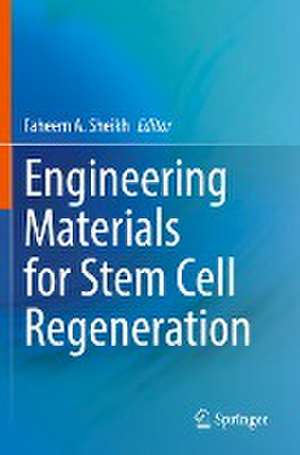Engineering Materials for Stem Cell Regeneration
Editat de Faheem A. Sheikhen Limba Engleză Paperback – 25 oct 2022
This book reviews the interface of stem cell biology and biomaterials for regenerative medicine. It presents the applications of biomaterials to support stem cell growth and regeneration. The book discusses the stem cell interactions’ with nanofiber, gradient biomaterial, polymer- and ceramic biomaterials, integrating top-down and bottom-up approaches, adhesive properties of stem cells on materials, cell-laden hydrogels, micro-and nanospheres, de-cellularization techniques, and use of porous scaffolds. Further, this book provides a basic introduction to the fabrication techniques for creating various biomaterials that can be used for stem cell differentiation. It also elucidates the properties of stem cells, their characteristic features, tissue culture technology, properties of pluripotency, osteogenesis, and biomaterial interaction with de-cellularized organs, cell lineage in vivo and in vitro, gene expression, embryonic development, and cell differentiation.
Further, the book reviews the latest applications of bio-instructive scaffold for supporting stem cell differentiation and tissue regeneration. The book also presents stem cell for dental, alveolar bone and cardiac regeneration. Lastly, it introduces engineered stem cells for delivering small molecule therapeutics and their potential biomedical applications.
| Toate formatele și edițiile | Preț | Express |
|---|---|---|
| Paperback (1) | 767.50 lei 38-44 zile | |
| Springer Nature Singapore – 25 oct 2022 | 767.50 lei 38-44 zile | |
| Hardback (1) | 1249.63 lei 3-5 săpt. | |
| Springer Nature Singapore – 24 oct 2021 | 1249.63 lei 3-5 săpt. |
Preț: 767.50 lei
Preț vechi: 1009.86 lei
-24% Nou
Puncte Express: 1151
Preț estimativ în valută:
146.88€ • 152.78$ • 121.26£
146.88€ • 152.78$ • 121.26£
Carte tipărită la comandă
Livrare economică 10-16 aprilie
Preluare comenzi: 021 569.72.76
Specificații
ISBN-13: 9789811644221
ISBN-10: 9811644225
Pagini: 706
Ilustrații: XVII, 706 p. 137 illus., 117 illus. in color.
Dimensiuni: 155 x 235 mm
Ediția:1st ed. 2021
Editura: Springer Nature Singapore
Colecția Springer
Locul publicării:Singapore, Singapore
ISBN-10: 9811644225
Pagini: 706
Ilustrații: XVII, 706 p. 137 illus., 117 illus. in color.
Dimensiuni: 155 x 235 mm
Ediția:1st ed. 2021
Editura: Springer Nature Singapore
Colecția Springer
Locul publicării:Singapore, Singapore
Cuprins
Chapter 1_Introducuction to a different material for stem cell regeneration.- Chapter 2_Bioceramic and stem cells.- Chapter 3_Decellularized Biomaterials using stem.- Chapter 4_Injectable materials for Osteoarthritis.- Chapter 5_Hydrogels and stem cells.- Chapter 6_Injectable Nanocomposite Hydrogels.- Chapter 7_Titanium Dioxide for Bone Tissue Engineering.- Chapter 8_Stem cell and ceramic nanomaterials.- Chapter 9_Interaction of polymeric nanofibers with Stem cells.- Chapter 10_Silk fibroin nanofibers and their role in oestrogenic differentiation.- Chapter 11_Neural cell regeneration using scaffolds.- Chapter 12_Silk scaffolds and their role in bone regeneration.- Chapter 13_Pluripotent Stem Cells and biomaterial.- Chapter 14_Protein for Tissue Engineering and Regenerative .- Chapter 15_Dental Stem Cells and Polycaprolactone Scaffolds.- Chapter 16_HepaticDifferentiation of Pluripotent Stem Cells on biomaterials.- Chapter 17_Biomaterials for Osteogenesis.- Chapter 18_Biomimetic disease Modeling.- Chapter 19_Biomaterials in Autoimmune Diseases.- Chapter 20_Role of Stem Cells in delivery of essential pharmaceuticals.- Chapter 21_Interaction of Collagen and Hyaluronan with Stem Cell.- Chapter 22_Stem cells reaction with materials.- Chapter 23_Recent Advances in Stem cell medicine a molecular simulation approach.
Notă biografică
Dr. Faheem A. Sheikh is an Assistant Professor at the Department of Nanotechnology, University of Kashmir, India. He served as an Assistant Professor at the Department of Biotechnology at the Central University of Kashmir, India (2015-2016); Research Professor at the Nano-Bio Regenerative Medical Institute, Myongji University, South Korea (2014-2015); Assistant Professor at Hallym University, South Korea (2002-2014); Post-Doc/Research fellow at the University of Texas Rio Grande Valley, Texas, United States of America (2010-2012) and Research Professor at Myongji University, South Korea (2010). His research mainly focuses on fabricating nanomaterials used in tissue engineering.
Currently, he is heading a lab, which works on creating different nanomaterials that can be used in various biological applications; this includes cell culturing and microbial assays. He has considerable expertise in the fabrication of polymeric, ceramic, and metal oxide nanofibersusing electrospinning, as well as the production of porous scaffolds by solvent casting, salt-leaching, 3D printing, gas forming, sol-gel synthesis, phase separation, freeze-drying, and particulate leaching and self-assembly for hard and soft tissue engineering. He believes that we will always need new and intelligent materials to address the different challenges faced in tissue engineering science. He has more than 15 years of research experience in nanotechnology, focusing on tissue engineering and drug delivery. He has published more than 100 peer-reviewed articles and book chapters.
Textul de pe ultima copertă
This book reviews the interface of stem cell biology and biomaterials for regenerative medicine. It presents the applications of biomaterials to support stem cell growth and regeneration. The book discusses the stem cell interactions’ with nanofiber, gradient biomaterial, polymer- and ceramic biomaterials, integrating top-down and bottom-up approaches, adhesive properties of stem cells on materials, cell-laden hydrogels, micro-and nanospheres, de-cellularization techniques, and use of porous scaffolds. Further, this book provides a basic introduction to the fabrication techniques for creating various biomaterials that can be used for stem cell differentiation. It also elucidates the properties of stem cells, their characteristic features, tissue culture technology, properties of pluripotency, osteogenesis, and biomaterial interaction with de-cellularized organs, cell lineage in vivo and in vitro, gene expression, embryonic development, and cell differentiation.
Further, the book reviews the latest applications of bio-instructive scaffold for supporting stem cell differentiation and tissue regeneration. The book also presents stem cell for dental, alveolar bone and cardiac regeneration. Lastly, it introduces engineered stem cells for delivering small molecule therapeutics and their potential biomedical applications.
Caracteristici
Presents stem cell biomaterial-based therapy in regenerative medicine Discusses influence of nanomaterials on stem cell differentiation Explores the potential of stem cell technologies in tissue engineering
